Peanuts - a delicious and useful bean "guest" from South America, who has loved many people in our country. However, not all gardeners know that it is possible to grow an exotic culture independently, despite the features and differences in climatic conditions.
It turns out that the bean grass is an absolutely unpretentious plant that can develop not only in the warmth of the southern regions, but even in the middle of Russia. It is enough to know the basic preferences of peanut culture, landing conditions and plant care. All questions related to the cultivation of peanuts, both in the open soil and at home, are read in this selection of material.
Peanut, Botanical Help
Peanut cultural has several synonyms: peanuts underground or earthwood, characterizing the peculiarities of growing this plant. The word "peanut" itself is translated as "spider", which is associated with the presence of plants on the fruits of a reticular pattern resembling a web.
- The type of plant "Peanut" refers to the family of the same name ("peanuts") from the numerous legume family.
- The main purpose of this agricultural culture is to obtain its fruit - beans (mistakenly referred to as nuts). In many countries, peanut "Walnut" is widely used in the food industry and is cultivated on an industrial scale.
- Using the botanical terminology, it is correct to call peanuts not to nuts, but legged grass.
- Annultural culture, peanuts, grows in a height of 25 to 70 cm, depending on the variety and cultivation conditions.
- Branchy faceted shoots can be bare or sowned. They distinguish the bush and threshing form of cultural peanuts, depending on the type of shoots.
- The leaves in the plant are slightly pubescent, paired, different lengths (from 3 to 10 cm). Root system - rod, with well-branched side roots.
- Small peanut flowers, yellow - red or white colors, are collected several pieces into the stubborn inflorescences. The flowering of peanuts falls on the summer (June-July) and continues until the autumn. Moreover, one inflorescence blooms no more than a day, while not all flowers of the plant turn out to be reproductive. The fruits bring only those inflorescences that are formed at the bottom of the stem or underground.
- The fruits are represented by 2-4-seed beans and have an extended oval swollen form. As aging, the beans are practically "buried" into the soil, where they occur their final aging. Fully ripen beans in the fall, in September - October months. After ripening, the beans are not disclosed. On one bush of peanuts, about 40 beans with seeds ripen. In size and shape of the seeds resemble beans covered with reddish or yellow-beige skin. Peanut reproduction occurs with seeds.
Peanuts, Plant Features
South America is considered the historic homeland peanut, where this "nut" culture has been known since ancient times. In Europe, an earthen walnut hit the Spanish conquerors who appreciated the plant and considered it a non-replaceable product in maritime travel.
- Given the "southern" origin of annual culture, thermal-loving peanuts, as a rule, cultivate in the regions with a warm and mild climate, although it is not excluded to cultivation and in areas with cold climatic conditions.
- In the first half of the 20th century, in America, they became massively growing peanuts as a valuable food culture. Most of the nuts went on the manufacture of a popular peanut paste.
- Peanuts are used not only for the preparation of a variety of dishes and hot drinks, but also as an additional product in the process of making cosmetics, drugs, dyes, soaps and even chemical drugs for the destruction of harmful insects.
- Peanut butter is used in medicine as the basis for the preparation of many drugs.
- The cultivation of peanuts has a beneficial effect on the lean scarce soil, since the bean plant actively enriches the soil with nitrogen.
- In symbiosis with peanuts may also develop mushroom mycelium, which promotes rapid growth of legume culture.
- An unusual feature of peanuts is the education of the so-called. Ginofoor. This body appears after pollination of the flower, begins to "reach" to the ground, after which the fertilized margin is completely deepening in the soil so that fruits with seeds are matured.
Peanuts, beneficial properties of the plant
- Peanut fruits contain about 50% of oily oil, which consists of glycerides of a number of high-quality carboxylic acids (linoleic, pantoten, folic, etc.). Peanut oil belongs to the group of half-having oils (with a high indicator of the iodine number), widely used in convention and confectionery production.
- In addition to oil, annual seeds contain proteins, glutenines, globulins, starch, sugar, amino acids, group vitamins B, E, A, D, PP, and other useful substances.
- The fruit of the earthen walnut includes micro and macroelements (iron, magnesium, potassium, phosphorus), antioxidants. Thanks to these substances, peanut seeds are considered an effective means of preventing cardiovascular diseases.
- Peanut seeds are perfectly learned by a man, render a choleretic effect, contribute to the updating of cellular material, are prevention of many diseases (including atherosclerosis), slow down the aging processes.
- Peanut use is shown to people with increased excitability and nervousness, since this product has a calming effect, helps improve memory, restore vitality.
- High protein content allows the use of peanuts as a dietary basis for weight loss.
- Ground peanut seeds often serve as an additive in the production of chocolate and other confectionery products.
- From the seed peanut seasures prepare starch flour, saturated with proteins, and is a valuable animal feed.
- With caution, you should use "nuts" of peanuts (especially not purified) to people prone to allergies. Contraindication to the use of peanuts in food are diseases such as arthritis and arthrosis. Eating large quantity of peanuts (especially with skin) can cause diarrhea.
Peanut Sort and Varieties
The bean family includes about 70 species of peanuts.
Conditionally, all cultural varieties of peanuts can be divided into 4 groups:
- Peanut The Peanis Group includes Spanish varieties of small peanuts. Cultivates a plant in South Africa and in America. The main distinguishing feature of this varietal group is the highest oil content, compared with other varieties of earthwood. Mine in size of peanut seeds are used to produce peanut butter, making saline or sweet "nuts." The following varieties of peanuts were most popular: Dixie Spanish, Argentinean, Spainek, "Natal ordinary", "Comet", "Star", "Spankoma", "Florispan", "Spenet", "SPNKNROM", " Tamsche 90, "Spanko", "White Kore", "Wilco Shahers".
- A group of peanuts "Valencia" is essentially a subgroup "SPENIS" and is a variety of large beans. The group's bushes reach a height of about 120-130 cm and are considered to be tall plants. Fruits 3-seed, smooth, coated with red skin. The best varieties of the group: "Valencia 433", "Valencia Ukrainskaya".
- The Ranner Peanut Group is characterized by high taste qualities, superior to even varieties from the Spanish group. High-yielding varieties with major oblong seeds that are faster and easier to do. The fruits of the Ranner group are widely used to produce peanut butter and salt nuts. The best varieties are given such types of peanuts: "Dixie Ranner", "Bradford Ranner", "Virginia Bangch 67", "Ranner of North Carolina 56-15", "Egyptian giant", "Georgia Green", "Southeast Ranner 56-15 ", Ranner fragrant 458.
- Group of peanuts "Virginia" is a large and selective peanuts, which is roasted directly in the shell and is used mostly for making confectionery products. The most common varieties of peanuts are recognized: "Shulamith" "Wilson", "Hull", "North Carolina 7", "Gregory," "Perry", "Virginia 98R», «Virginia 92R", "North Carolina 9".
Buy raw peanut seeds can be in a normal grocery store or market. Naturally, the beans should not be pickled, candied or toasted. In this form the seed material is only the nutritional value and 100% sterility.
When you purchase is necessary to give preference to a strong close-bean pods, free of mold and damage with a clear and textured mesh pattern on the surface.
Peanuts in the garden, photo
Peanut planting in open ground
Peanut plant - one of the few crops that are inherent in the phenomenon of geokarpiya (introduction of the ovary and fruit development in the soil). In this flowering of peanut flower lasts only a day, and during this time he should have time to pollinate. Only in the case of successful pollination of the flower will develop peanut fruit.
Peanuts grow in your garden is quite a feasible task. However, many growers say the relative simplicity and good performance of the plant yields.
Consider the main features of peanut planting in open ground.
Terms of peanut planting
- Peanut planting seeds or seedlings can be, and for this purpose, either peeled seeds or whole pods. The first method (the seed) is preferred for southern regions with a warm climate soft. Planting seedlings raisings - the best option for cold regions, such as central Russia. Seedling method allows you to collect peanut harvest 2-3 weeks earlier.
- Given the properties of thermophilic peanut seeds are planted in open ground in the second half of the spring, when the ambient temperature is at least 18-20 0C, and the soil warms up to + 12-15 0C. As a rule, this period is in the middle of May and on terms equal to planting melons. If the beans are planted early, there is a risk of rotting seeds in cold soil. In addition, thermophilic could not bear the return spring frosts.
- As for planting seedlings, seeding into a container with soil mixture (or individual cups) is carried out earlier: at the end of March - early April, and at the age of 1-1.5 months the already tempered seedlings are transplanted to the garden. The depth of seed seeds into the ground is about 3-4 cm, and it is better to soak the seeds before planting seedlings in water for several hours.
- If the planting of peanuts is carried out in the regions with a cold and unstable climate, for example, in the middle lane of Russia, it is important to provide a temporary film shelter used in the event of an unexpected cooling.
- The selection of the area and the preparation of the soil for planting peanuts is of great importance, since the fruits ripen in the ground. For peanuts, they pick up well lit, solar bed with light, loose and fertile soil. A terrain with a light or short-term shadow is also suitable. By the type of soil, the best option will be soverees, lightweight loams or sandy soil. Culture will not develop in saline or acidic soil, so such a soil will need to be balanced before landing: the salt and gypsum should be added to the saline soil, and in the acid - lime.
- If you adhere to the rules of crop rotation, legume crops are best planted after such vegetables, like: cucumbers, cabbage, potatoes. These representatives of the cabbage family reduce the risk of peanut infection with such a dangerous fungal disease as fusariosis. Do not land peanuts after your legumes "relatives" having common pests and typical diseases. As "neighboring" cultures, the representatives of the family are best suitable: eggplants, tomatoes, potatoes, peppers.
Agrotechnology planting peanuts
- The bedding for planting peanuts is preparing in advance in the fall: remove all the weary grass, they are drunk and at the same time (under the pext) make a humus at the rate of 1-3 kg per 1 m 2 Earth. Spring plot again shallowly picked up or loosen, and nitroposku is added to the soil (approximately 50 g per 1m 2). Apply fresh active organic fertilizers (manure, litter) For legume crops, in no case, because the organic can destroy useful nitrogen intimating bacteria, located on the roots of peanuts.
- For landing it is better to calibrate the seed material and leave only the largest and viable seeds. To increase the germination of peanut seeds, when sowing them it is better to extract from the shell and clean it from the skin. Moreover, the peel is also thrown into the landing well to provide subsequent settlement on the roots of the plant of useful mushrooms.
- Purified seeds are placed on a flat plate, a napkin (or a melt, gauze), moistened in warm water and leave for a week to germinate. As a drying, the napkin is constantly moisturized. For these purposes, a weak solution of potassium permanganate (manganese) can be used, which provides an additional disinfecting effect. Sprouted seeds with small roots are ready for landing in the ground (on a garden or seedlings).
- Seeds are sown in pre-prepared wells. The depth of seed seeds into the open soil is about 6-10 cm. Considering the business of the plant, the distance between the wells should be at least 50 cm, between the rows - 30 cm.
- There are a variety of peanut planting schemes for a bed: square-nesting (60x60cm or 70x70 cm) or a wicked (with a framework of 60 cm and the distance between the bushes in the row - 20 cm).
- In one hole, there are 2-3 seeds, given the likelihood of a low germination of smaller seeds.
- After landing, the hole is slightly plugged and pour out abundantly. For irrigation, it is better to use the sprayer to use a strong jet to blur the soil.
- When sowing seeds in an open ground, the garden is covered with branches so that the birds do not turn the seeds. After 10-14 days, the first friendly shoots of peanuts appear.
Growing peanuts on seedlings
- When sowing seeds in seedlings, you can use a varied container: peat pills, disposable cups or a common wide container.
- Preparation of peanut seeds as when landing into open ground, it does not differ in the seedlings.
- The soil must necessarily be light and breathable. To do this, in soil, even "purchased", it is better to add a little sand.
- The depth of seed seeds is less than in the open soil and is only 2-3 cm.
- Capacity with seeds desirable to cover with glass or film and put in a warm place.
- Care for "mini-greenhouse" includes: watering, venting and removing condensate. After the first leaflet appears at the seedlings, the shelter is removed, and the tanks with the seedy are rearranged into a well-lit and warm place.
- Thirsty and tempered seedlings are planted outside on a cloudy day.
Growing peanuts in room conditions
It is possible to grow peanuts at home, and this procedure does not differ much from the method of planting bean seeds described above.
- You can plant as peeled peanut seeds and whole pods of legumes. Seed material (seeds are soaked in advance in warm water overnight) planted into a container or a large flower pot with a light soil mixture of early spring (in March-April). If pods are used, before landing, they should be slightly compressed so that the seeds are easier to germinate.
- The depth of seed seed in the ground is about 2-3 cm, given that the seedlings will germinate in "comfortable" room conditions, without the threat of spring frosts.
- Capacity with seeds are covered with glass or film (you can simply "wear" a transparent polyethylene package with several holes) and left in heat (at least + 20-22 0C), bright place, without drafts. Too high temperature (over +30 0C) Peanut content is also destructive for the plant.
- Care of seedlings includes: moderate watering (and then spraying bushes) and the ventilation of the "mini-greenhouse" (as soon as the seedlings go out, the shelter is cleaned).
- Too thickened planting peanuts thin, leaving the most developed and strong copies. In very hot days, the container with lush bushes of peanuts can be reached on the balcony.
- About a month later, room peanuts will begin to bloom, after which the formed hypophoras deepen into the ground for further aging underground.
- After 3-4 months from the moment of the appearance of germs, the peanut fruits are completely ripening and ready for cleaning.
Peanut care
Given the "southern" origin of peanuts, it is easy to understand that 3 factors will be the best conditions for the legawing culture: heat, sun and moderate humidity. It is important to remember that the thermo-loving plant will not be able to develop further if the air temperature drops to +15 0C. In connection with this, in the case of possible return freezers, planting peanuts should be immediately covered with a film or any other undercover material. Gentle peanut shoots die even with a slight decrease in temperature.
The growing season of growing peanut is 120-160 days (from landing to harvest). Interesting is the fact that the plant simultaneously blooms, increases green mass and forms fruits.
Consider the main agrotechnical activities for the care of peanuts.
Watering, loosening and hyphenation of peanuts
- Peanut is well evolving in a wet, but not wet soil, so the plant is watered moderately, as the surface layer of soil dried. With prolonged protracted precipitations, you can cover the bed with a peanut film, so that the beans do not start or make the "rejected" channels, so that the water was not stuck on the garden.
- Watering rates slightly increase in the hot season and during the flowering period of legume culture. Approximately 3-4 weeks before harvesting, watering is reduced, and in 2-3 weeks - completely stop.
- During flowering, peanuts need spraying, which is spent, more often, in the evening. Good results also gives the organization of drip irrigation.
- After irrigation, the soil must be exploded. In addition, during the development of seedlings, it is important to remove weary grass in time on time to "not scoring" peanut gentle sprouts.
- Another important procedure necessary for this legume culture is to glue the bush of the plant (like potatoes). Pulling is carried out in the period when the wound will start germinate into the soil. The procedure is of great importance, since, if you do not cover the ovary, they can dry and without developing fruit. Given that this process is a little stretched in time, plunge the bushes of peanuts several (3-4) times per season. You can dip the bushes or a mixture of peat, sawdust, humidiation and sand. It is important to remember: the greater the land the stem is, the more the tiers of the wound, and therefore the long-awaited fruits.
Making fertilizers and feeding peanuts
- Subject to the planting of peanuts in fertile soil, additional fertilizer application in the soil is not necessary.
- If there is a desire to increase the yield of culture, the mineral feeding of potassium nitrogen by phosphoric fertilizers is allowed.
- The first feeding is carried out in the summer when shoots reach 10-15 cm in height. For this, a solution of complex fertilizer is prepared: 20 g of ammonium nitrates, 45 g of potassium salt and 70 g of superphosphate are dissolved in a bucket (10 l) of water. Such a "nutrient" solution watered young seedlings.
- The second mineral feeding falls on the beginning of the start of fruiting.
- Fertilizer makes it possible to get friendly healthy shoots and a rich harvest (almost 2 times superior harvest without additional feeding).
Fighting pests and peanut diseases
- The most common peanut diseases: mildew, fusarious wilt, philostose, gray rot and alternariasis.
- The appearance on the plant spots of characteristic mildew, which eventually grow and lead to the drying of the leaves, indicates infection with a torment dew. The disease amazes almost all parts of the plant. Systemic fungicides are used to combat fungal infection: "Topaz", "Bravo", "Chorus", "Svitch" and others.
- The philostose is called another spottedness of the leaves, since the disease can be detected by the appearance of small brown spots on the leaves of peanuts with purple edge. This disease occurs especially often during high humidity. To solve the problem, fungicides are widely spectrum.
- Alternariasis or black spot of leaves is characterized by the formation of dark spots, which then grow and merge. For "treatment" of fungal disease, fungicidal drugs will be needed.
- Fusarious wilt is a dangerous disease that causes root rot, the termination of the development of the plant and its further death. Progresses fusariosis in the phase of bootonization and the beginning of flowering. There are no radical measures to combat fungal infection, but to warn fuzarious fading helps compliance with competent agricultural engineering and timely harvesting.
- Brown-brown spots on the leaves and peanut stems and associated with them, fading the topless shoots, as well as the deformation of the fruits, indicate the infection of the plant with gray rot. The disease is actively manifested in a wet warm period, usually at the end of summer. Prevent the appearance of gray rot, possibly subject to all agrotechnical events.
- Of the pests of peanuts, most often meet: triples, caterpillars, wires and a wave.
- If the pearanty insect pests (Tsley or caterpillars) have become on the perabut bush, it is possible to use folk methods to begin with: sprinkle plants and beds with a mixture of tobacco dust and wood ash.
- As for the TRIPS, these insects should be exterminated using insectoacaricidal drugs.
- Wireframes - Locks Nutcalne, which inhabit the soil. They feed on peanut seeds, gradually destroying landing of leggings. To destroy pests, they are used, for example, special traps (pits with pieces of vegetables, covered with a plank). The prophylactic of the appearance of the wires will be systematic removal of weed grass, compliance with the rules of crop rotation and agrotechnology.
Harvesting peanut
On average, one peanut bush produces from 30 to 50 legumes containing, in turn, from 1 to 7 seeds.
- Collect the peanut harvest begin in the first half of autumn, when the leaves of the plant begin to shut up, and the bushes to lower. You can, first, to dig up a few "control" peanut bushes and check whether the seeds of the pod are caused. If they are easily separated - you can safely assemble the entire harvest.
- It should not be tightened too long with the timing of harvesting, since after frosting and freezing of the soil, the seeds become good and no longer suitable for eating. In addition, approximately, since October, the amount of natural precipitation increases, and peanuts can simply be contrary to the ground. Another minus of the late harvest is, even if, there was no rain, and the peanut bushes are completely dried, - overwhelmed seeds can turn to the ground right during cleaning.
- Digging peanuts from beds best than a pitchfork. In large scale used mechanized technique. After removing the beans from the ground, they are slightly shaken, turn over and leave on the garden to dry in the sun. Then the pods are separated from the stems and dried on the street (about a week) to dry state.
- Store pods with peanut seeds in dry, cool (with a temperature of about +10 0C) and a ventilated room, in a tissue bag. You can also immediately extract peanut seeds from pods. Seeds will have a characteristic bright pink color. If the peanut landing is planned for the next year, it is recommended to immediately select the best (large, healthy seeds) planting material.
Thus, exotic peanuts can always be "at hand", if we grow it yourself on a garden, in a greenhouse or a conventional flower pot. The main condition for the successful cultivation of the thermal-loving culture is to comply with the basic rules of landing and care for peanuts.

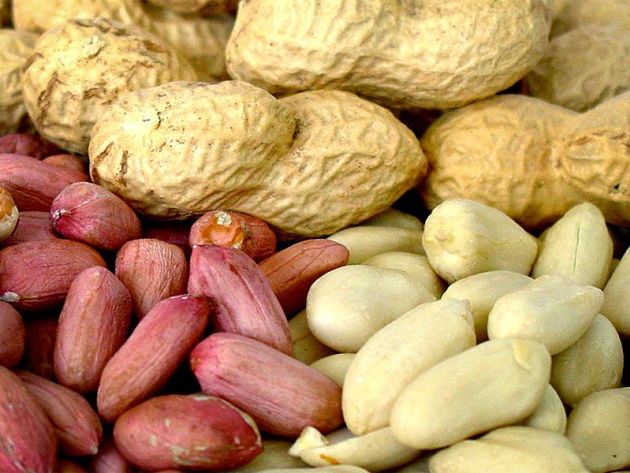

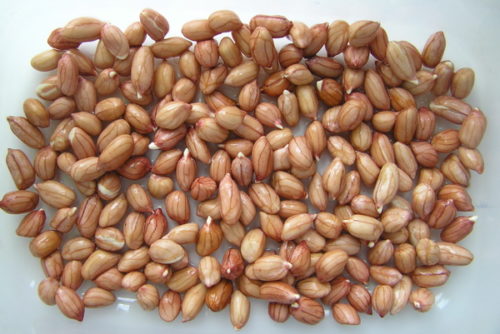
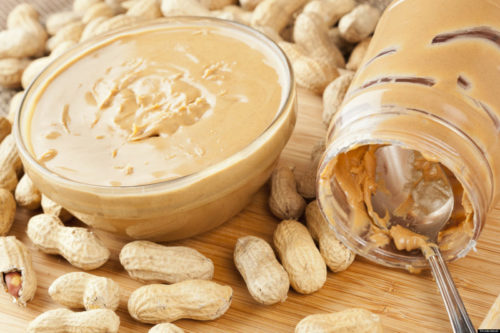
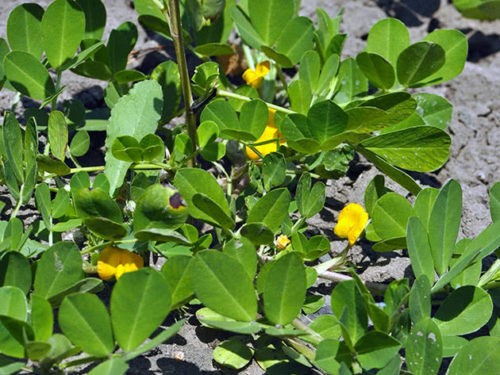
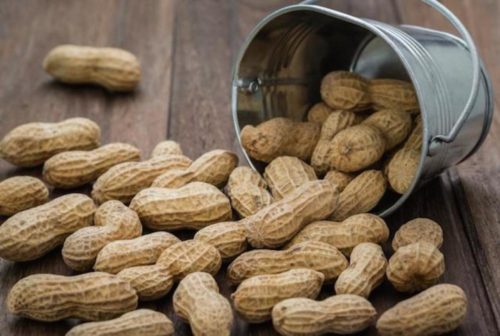
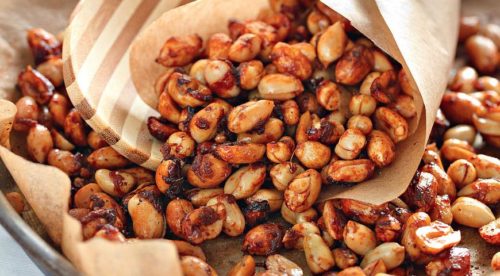

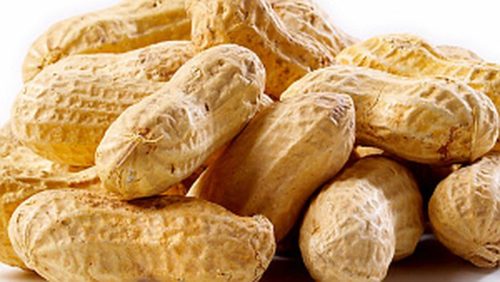
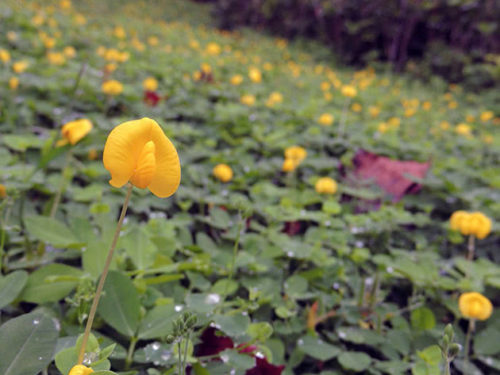

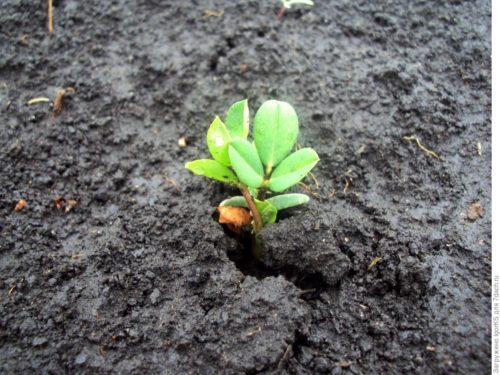

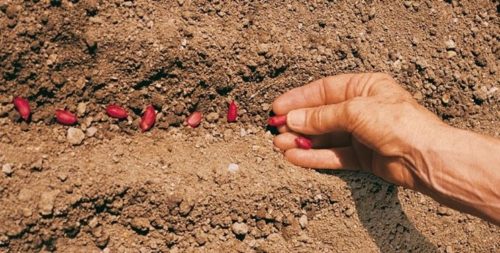


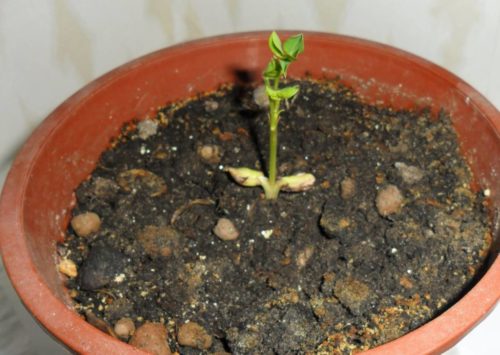

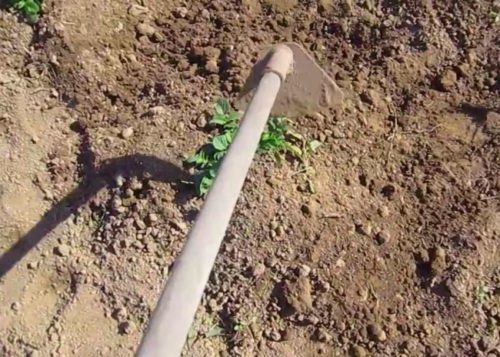

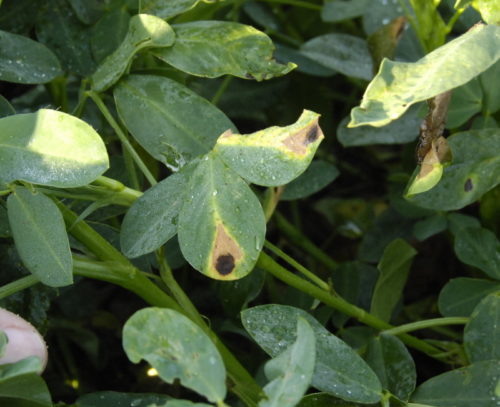
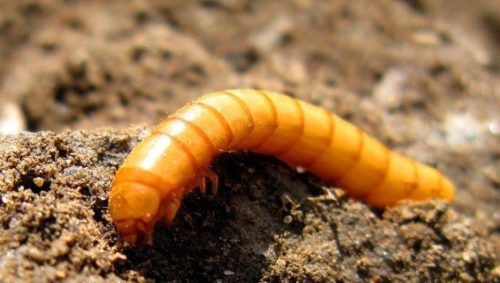

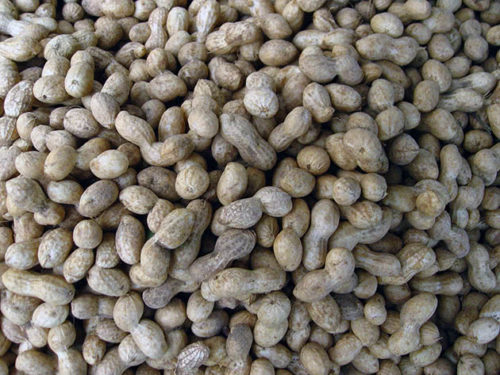
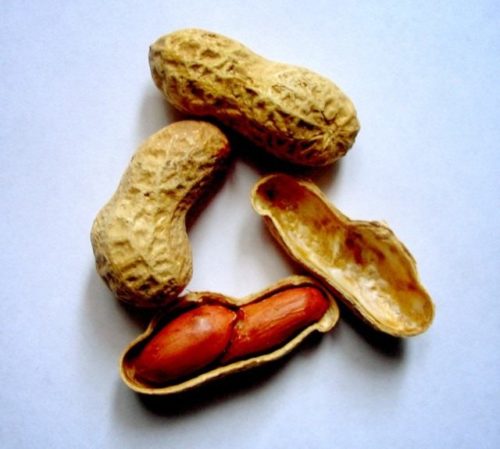












 Start a discussion ...
Start a discussion ...